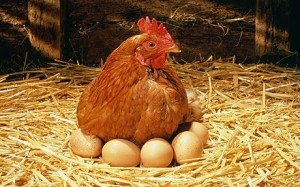I’m an animal lover, as you might know. The idea of eating horse appals me, and Captain is certainly ‘Top Dog’ at Nina & Co HQ. So when it comes to putting meat on my table, I want to know where it came from and I want to be sure the animals were well-treated before giving their all for my dinner.
We’ve got traceability and provenance on some products, but just not enough (horse meat again!) But is the public confused by all these different terms being bandied about? I don’t think there is anything more ambiguous in the food industry than the term ‘free range’.
Oh… it all sounds quite idyllic. Chickens roaming around the beautiful countryside, happily pecking and scratching under trees, before going off and obligingly laying our daily eggs. Pigs roaming the fields and wallowing in their rural paradise before sleeping it off in their comfy, cosy arks. Pigs are yet another story, though, and one I’m saving for another day.
But when it comes to chickens and eggs (which DID come first?) what does free range really mean? What’s the difference between organic, free range, barn reared, Freedom Food, Happy Chickens, and everything else in-between?
I wanted the facts, so I got out my amateur sleuthing kit and magnifying glass to investigate… and it’s not so ‘elementary, my dear Watson’ as you might think.
Let’s deal with ‘organic’ first. Organic food has to be reared or grown without benefit of artificial intervention, be that chemical insecticides, or pesticides. To use the term organic, the producer must be registered with an organisation such as the Soil Association or the Organic Farmers and Growers.
Freedom Foods or free range foods don’t have to be organic, though. So don’t make the mistake of confusing these terms.
Some chicken facts…
- Around 11 billion eggs are consumed in the UK each year
- Approximately 85% of these are reared in the UK
- Around 800 million chickens are eaten in the UK each year
- Only 45% of eggs eaten in the UK are free range (2010)
- 5% of eggs come from barn reared chickens
What does free range really mean?
The law governing ‘free range’ comes from our friendly bureaucrats in Brussels. To qualify for the honour of being free range, the hens must have continuous daytime access to the outdoors. No more than 2,500 birds can be reared per hectare (2.47105 acres). The farmers are encouraged to make the birds’ environment as attractive as possible, but this is not controlled in any way.
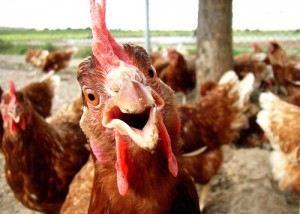
While this all sounds great, I wonder which civil servant did the calculations. If you visit a chicken farm to see the free range birds at home, you’re more likely to see an empty field and a great flock gathered alongside the hen houses. Is that free range calculation right? Should chickens have as much space as they want or need, rather than being dictated to by the EU statisticians?
What does this mean to us as consumers? If you keep a couple of chickens in your back garden, you can’t actually call them free range, unless you comply with the EU legislation. Similarly, buying eggs at a farm gate doesn’t mean they’re free range, but they could be described as farm reared or farmyard eggs. Complicated stuff, isn’t it?
Barn reared poultry
This is probably one of the most misunderstood terms in the whole chicken and egg debate. Personally, I think it’s quite a clever marketing ploy and demonstrates how a bit of smart wordsmithery can change people’s perception.
When you hear the term ‘barn reared’, you could be forgiven for thinking of cutesy barn conversions and pampered chooks living the dream in their rustic idyll, safely tucked away from Foxy Loxy as he seeks his chicken supper.
Sadly, that’s an illusion. ‘Barns’ are huge sheds known as ‘percheries’, which can accommodate tens of thousands of birds. The EU legislation states a maximum stocking density of 9 birds per square metre. It’s not exactly gracious living, is it?
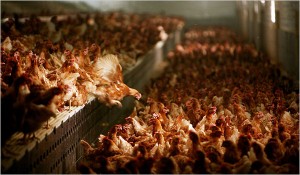
These intensively reared birds never see the light of day and are still routinely debeaked to prevent them pecking each other. On the plus side, it’s a step up from battery egg production.
Freedom Foods
This is an accreditation awarded by the RSPCA. Remember, it’s nothing to do with organic production. Freedom Food governs the animals’ welfare. Producers must apply for registration and are regularly inspected to make sure they comply with the standards set by the RSPCA.
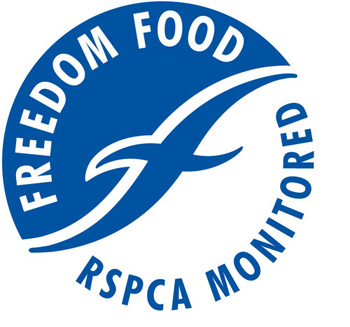
Although the certification is called Freedom Foods, chickens can still be reared indoors with no access to the outside world (so much for freedom, eh?) But on the plus side, they should have more space and a more ‘natural’ environment provided. But read on… even Freedom Foods aren’t always what they seem.
Ha! Rant time! If the image of barn eggs or poultry is down to some skilful word play, the Happy Egg Company’s marketing must be sheer skulduggery! You’ve got to love the advert showing the happy Freedom Food farmer buzzing round the farm on his quad bike tending his flock of ecstatically chirpy chooks.
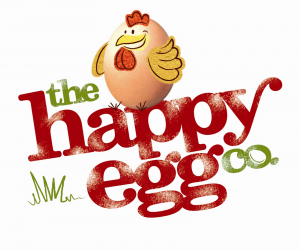
But dig around a little further and you’ll find this video exposé by Viva! (Vegetarians International Voice for Animals charity) filmed in 2010, showing the plight of these not-so-happy birds. WARNING, this video contains scenes you may find disturbing!
I was hoping these conditions and the disgraceful misrepresentation of Happy Eggs and its Freedom Food accreditation had been addressed nearly 3 years on. But then I stumbled on something more recent and even more disturbing … a report in the Guardian in October 2012 about “Workers who collected Freedom Food chickens ‘were trafficked and beaten!”
All I can say is the Freedom Food campaign is falling very short of its goals. And if the human workers can be treated this badly, what hope is there for the animals?
So where does that leave us, the consumer? Confused? Yes, understandably. But we DO have a voice and we have to use it. Frequent your local butcher and farm shops. Question where and how your meat is reared and insist on knowing its provenance. Because remember, when it comes to our food chain, the terms free range and even Freedom Foods, it’s clear we can’t rely on what it might say on the tin!

